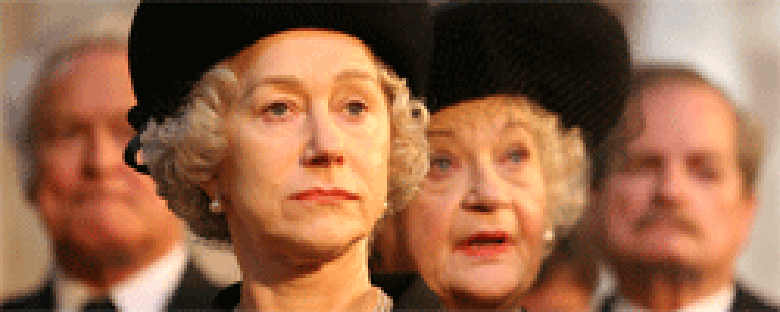Reviews
Stephen Frears
UK / France / Italy, 2006
Credits
Review by Beth Gilligan
Posted on 04 October 2006
Source Miramax 35mm print
Related articles
Features: The 44th New York Film Festival
The Queen begins, fittingly, with a shot of Her Royal Highness Elizabeth II perched against a black backdrop, her likeness being etched for an official portrait. In sharp contrast to this still life is the figure on the TV screen beside her: Tony Blair, in all his youthful vigor, on the eve of being elected Prime Minister. For director Stephen Frears, this pairing of the traditional and the modern is central to understanding the sea change Britain has undergone over the past decade. Yet while Frears goes out of his way to paint Queen Elizabeth as hopelessly out of touch with the world around her, the movie also is tinged with a certain mournfulness for a country that once prided itself on its stoicism and rich historical legacy.
The film begins in the spring of 1997, as Blair readies himself to become England’s first Labour prime minister in 18 years. Bursting with energy and vision for change, he regards the Queen as little more than a necessary evil, or, as his wife Cherie later puts it, one in the long line of “freeloading, emotionally-retarded nutters” the Brits affectionately refer to as The Royal Family. Elizabeth, for her part, seems to hold the Blairs in similar regard. During her first closed-door session with the new prime minister, she makes pointed reference to the very same private meetings she used to have with Winston Churchill, and remains frostily unimpressed by Blair’s boyish attempts to charm her.
Their two worlds collide, however, in the aftermath of Princess Diana’s sudden death in a car accident the following August. For these scenes, Frears uses actual footage from the news coverage of the Princess’ death, allowing viewers to glimpse Diana as she was always seen by the public — beautiful, vulnerable, warm-hearted — but seemingly never by the Royal Family. This divide between the public and private perception of the Princess only widens in the aftermath of her death.
While the Queen’s immediate reaction is to withdraw from her subjects, shielding her family from the media onslaught and avoiding comment on the life of a woman she clearly despised, Blair reaches out to the grief-stricken public with a speech in which he anoints Diana “the people’s princess.” The scales are tipped, with public opinion lurching violently against the monarchy.
Just as his rendering of the secondhand record shop milieu in High Fidelity was pitch-perfect, Frears’ vision of the sanctified world inhabited by the Royals is similarly on-target. The stark, untouched beauty of the Scottish countryside (where the Queen and her family are holed up when they hear the news about Diana) serves not only as a perfect contrast to London, where frenzied crowds gather to drop off flowers in front of Buckingham Palace, but also as a reminder of Britain’s past. As the country begins to erupt in anger at the Queen’s silence over Diana, Elizabeth and her family move around obliviously, stopping for tea and arranging hunting trips to distract the young princes from their grief. Only Blair’s phone calls, polite but of increasing urgency, rattle the Queen’s steadfast belief that Diana’s death is a matter best handled privately, and that the fuss will subside in a day or two.
Frears takes great pains to underline the disparity between this rarefied universe and that of the prime minister’s, shooting the cluttered Blair household in warm tones and lingering on objects such as Blair’s guitar, football jersey, and drawings made by his children. While this depiction occasionally strains credibility (I find the notion of Cherie Blair preparing fish sticks for her family roughly as plausible as that of Hillary Clinton flipping hamburgers on the grill), it emphasizes the prime minister’s connection to his public, something that has long slipped away from the Queen.
Still, while The Queen includes many laughs at the Royal Family’s expense, Helen Mirren’s portrayal of Elizabeth grants her a depth that she may well have been denied in less talented hands. Just as Meryl Streep transformed what was a two-dimensional character on the page into a smart, prickly, complicated woman in The Devil Wears Prada, Mirren takes a woman who could have easily become a punch line and imbues her with wit, heart, and a touch of sadness. Once admired for her resolve and discretion, the Queen is both heartbroken and bewildered to witness her subjects slip away from her and to face the prospect of thousands of years of traditional unraveling under her watch. To her vast credit, Mirren manages to register these emotions without wearing them on her sleeve (as was Diana’s forte). Michael Sheen’s performance as Tony Blair also demonstrates a talent for rising above caricature, as he conveys the Prime Minister’s simultaneous distaste and affection for the monarchy.
In the end, Blair’s ability to read the national mood trumps the Queen’s, but as Elizabeth slyly hints at the film’s denouement, the prime minister may one day find himself at the brunt of the public’s outrage. Diana’s death may have pushed the country a step further in ridding itself of its monarchy, but just as Blair finds himself increasingly sympathetic towards a woman who has endured wars and turmoil both public and private, it appears that the British people are not yet able to let go of this institution, even as its historical legacy gives way to tabloid fodder.
We don’t do comments anymore, but you may contact us here or find us on Twitter or Facebook.



